ProxiMeta Kits & Services
Generating the Blueprints:
ProxiMeta™ Metagenome Deconvolution Platform
Master the Microbiome
The ProxiMeta Metagenome Deconvolution Platform combines cost-effective proximity ligation data (generated with our optimized kits) with shotgun sequencing data, to assemble high-quality metagenomes and associate mobile genetic elements with their hosts. Capture strain-resolution insights without relying on 16S-based techniques, binning or culturing.

Proximity ligation (Hi-C) libraries are generated from a single mixed microbial sample. Interactions are captured by crosslinking, digesting, and creating chimeric junctions that are sequenced and analyzed with a shotgun assembly to deconvolve chromosomes and plasmids into complete genomes.
From: Stalder, T. et al. The ISME Journal 2019; 13: 2437 – 2446.
Download to learn more
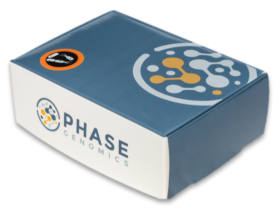
Features and Benefits
- Assemble high-quality genomes directly from the microbiome
- Associate plasmids, phages and antimicrobial resistance genes (ARGs) with their hosts
- No high-molecular-weight DNA or culturing required
- Short-read compatible; yields libraries for Illumina® sequencing
- User-friendly, 8-pack ProxiMeta Kit with cloud-based ProxiMeta Analysis included
ProxiMeta Workflow
The ProxiMeta Platform provides a sample-to-analysis solution that starts with a crude metagenomic sample, and ends with analyzed data. The entire process (depicted below) is typically completed in a month.

ProxiMeta workflow, from sample to analysis.
The proximity ligation (Hi-C) library prep constitutes a specialized part of the workflow. Our ProxiMeta Hi-C Library Prep Kits provide a streamlined protocol that does not require culturing of microbes or extraction of high-molecular weight (HMW) DNA. Processing guidelines for different types of metagenomic samples ensure robust results.
The 8-step library prep workflow (outlined below) can be completed in 2 working days, and requires only 3 hours of hands-on time. The protocol contains several convenient, safe stopping points.

ProxiMeta Hi-C library prep workflow.
If shotgun sequencing data is not yet available for your sample, shotgun library preparation may be performed with a suitable library preparation kit of your choice. Contact us for recommendations or to discuss a service project if you do not have prior experience with shotgun library preparation and sequencing.
Sequencing may be performed on any Illumina® sequencer. The ProxiMeta Kit yields a dual-indexed proximity ligation library, for which ~50 to 100 million paired-end reads are required.
All ProxiMeta Kits are now offered as bundles, which include free on-line ProxiMeta Metagenome Deconvolution analysis. Visit proximeta.phasgenomics.com to register, upload your files and perform your analysis, or to view example reports.
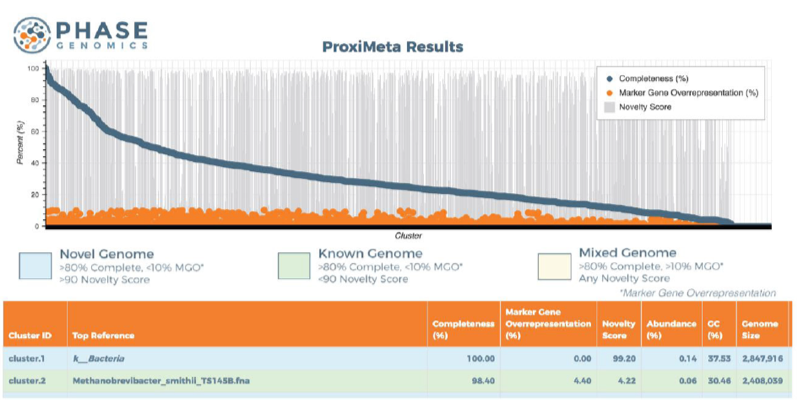
ProxiMeta deconvolves and assembles complete genomes of both novel and known microbes from a single sample.
Contact us for assistance at any time during the analysis process, with data interpretation, or if you are interested in additional analyses.
Download the ProxiMeta Library Prep Protocol
Key Applications
Click here for more ProxiMeta applications in Metagenomics & Microbiology or download the ProxiMeta Applications Guide
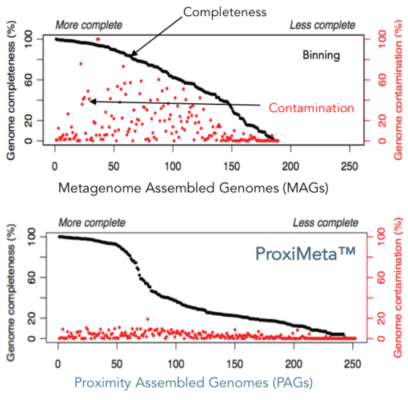
Assemble hundreds of high-quality genomes without guesswork
Metagenome assembled genomes (MAGs) generated by binning leaves genomes fragmented and contaminated. Unlike binning, proximity ligation provides direct, physical evidence of sequences co-located in the same cell. ProxiMeta uses this information to cluster proximity-assembled genomes (PAGs) for both eukaryotic and prokaryotic members of the microbiome population. Each genome is assessed for completeness, contamination and novelty using industry-leading computational tools.
ProxiMeta outperforms binning to generate more complete and less contaminated Proximity Assembled Genomes (PAGs). From: Press, M.O. et al. bioRivx (October 2017).
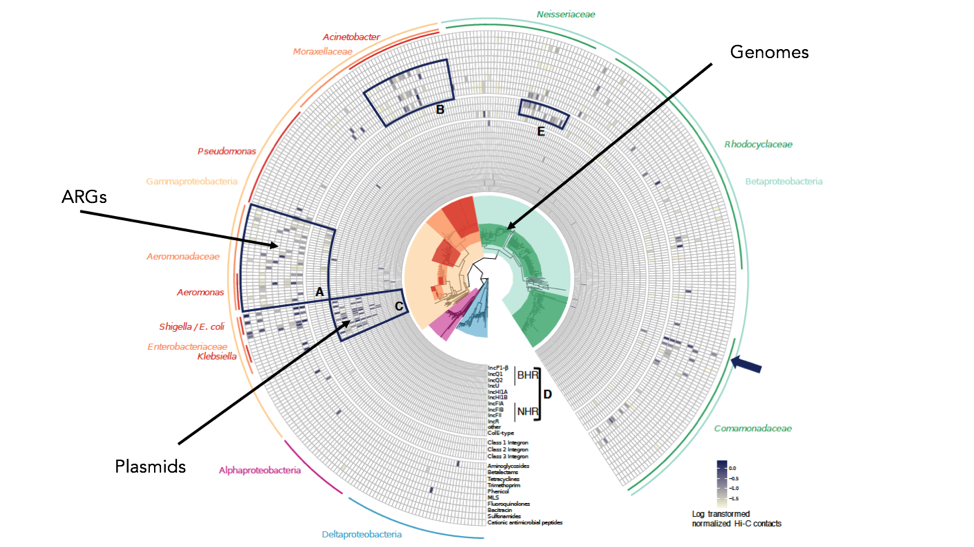
Link plasmids and antibiotic resistance genes to their hosts
In addition to genome assemblies for the members of a metagenomic sample, the ProxiMeta workflow also yields sequence information for mobile genetic elements (MGEs). These may include plasmids, transposons and antibiotic resistance genes (ARGs). Since proximity ligation is performed on intact cells, MGE-host interactions are also captured. During the ProxiMeta assembly, mobile genetic elements are associated with their hosts with a high degree of confidence. This allows you to gain insight into horizontal gene transfer in complex microbial communities.
Genomes assembled from wastewater arranged in an evolutionary tree (center), showing which are hosts to different mobile elements (middle rings). Bacterial families for each genome are displayed in the colored outer ring. From: Stalder, T. et al. The ISME Journal 2019; 13: 2437.
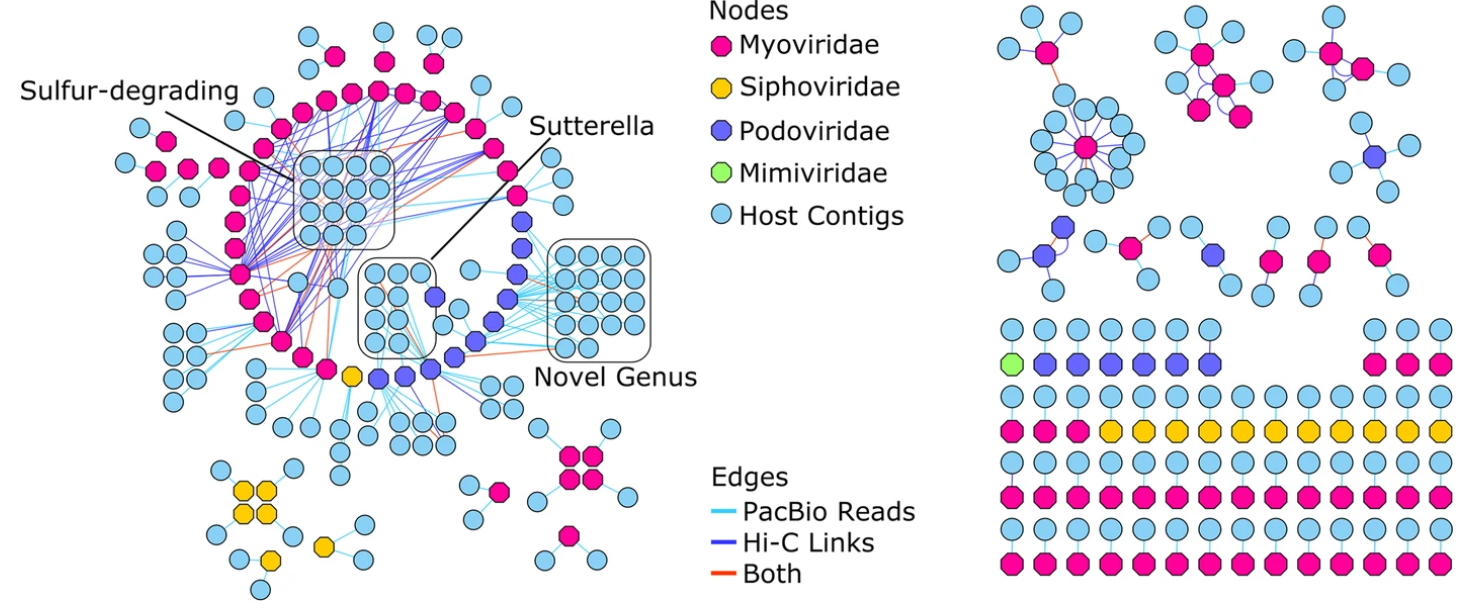
Assign phages to their hosts
During proximity ligation library prep, phage and viral DNA is crosslinked to the DNA of bacterial hosts within a mixed microbial sample. Those interactions are captured in the sequences of chimeric junctions, which allows the ProxiMeta algorithms to accurately assign phages to their hosts during the deconvolution analysis. Phage-host attribution produces a more accurate view of the microbiome from a single Hi-C library.
Network analysis of long-read alignments and Hi-C intercontig links identifies hosts for assembled viral contigs. From: Bickhart et. al. Genome Biol. 2019; 20: 153.
Support & Resources
Software and example reports
Read more
Frequently Asked Questions
Watch to learn more
